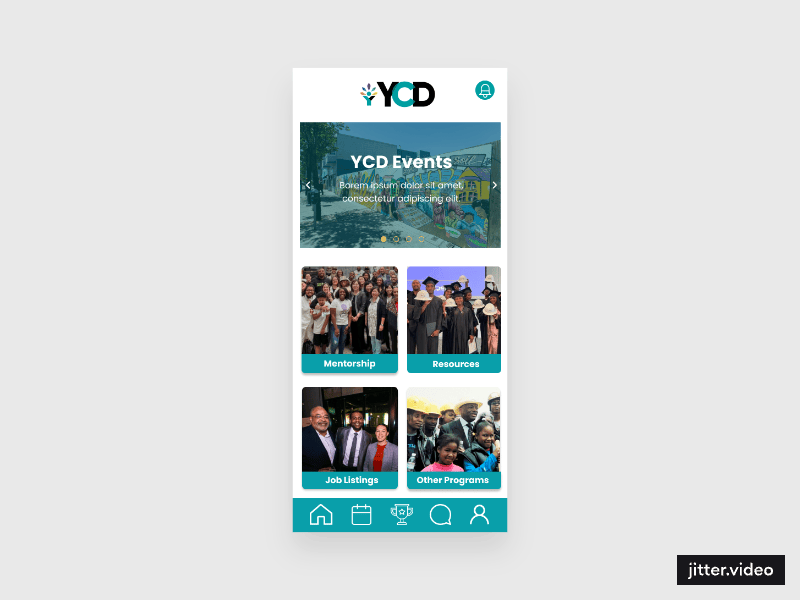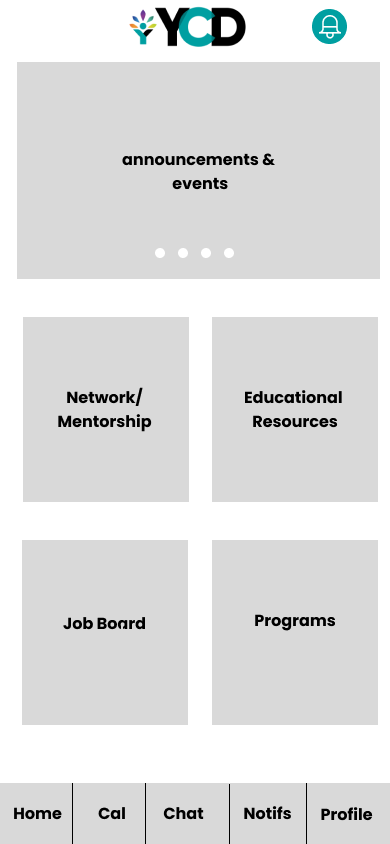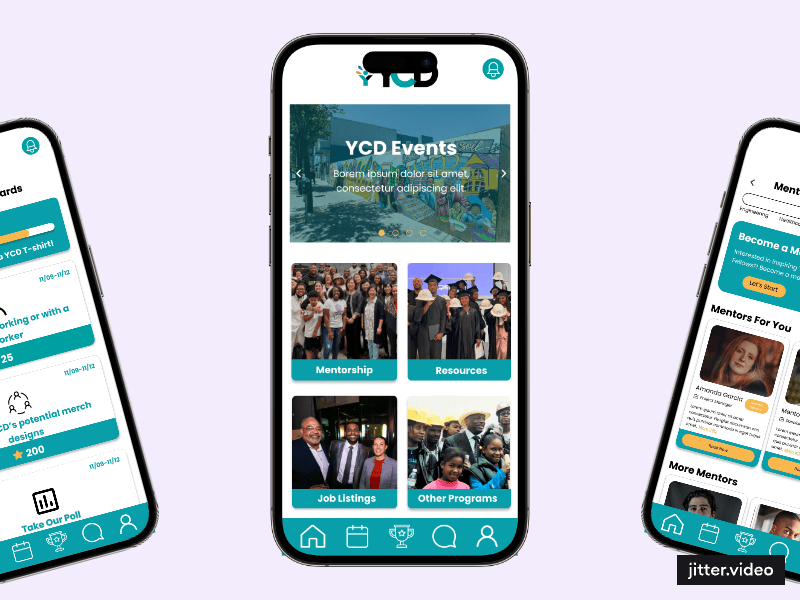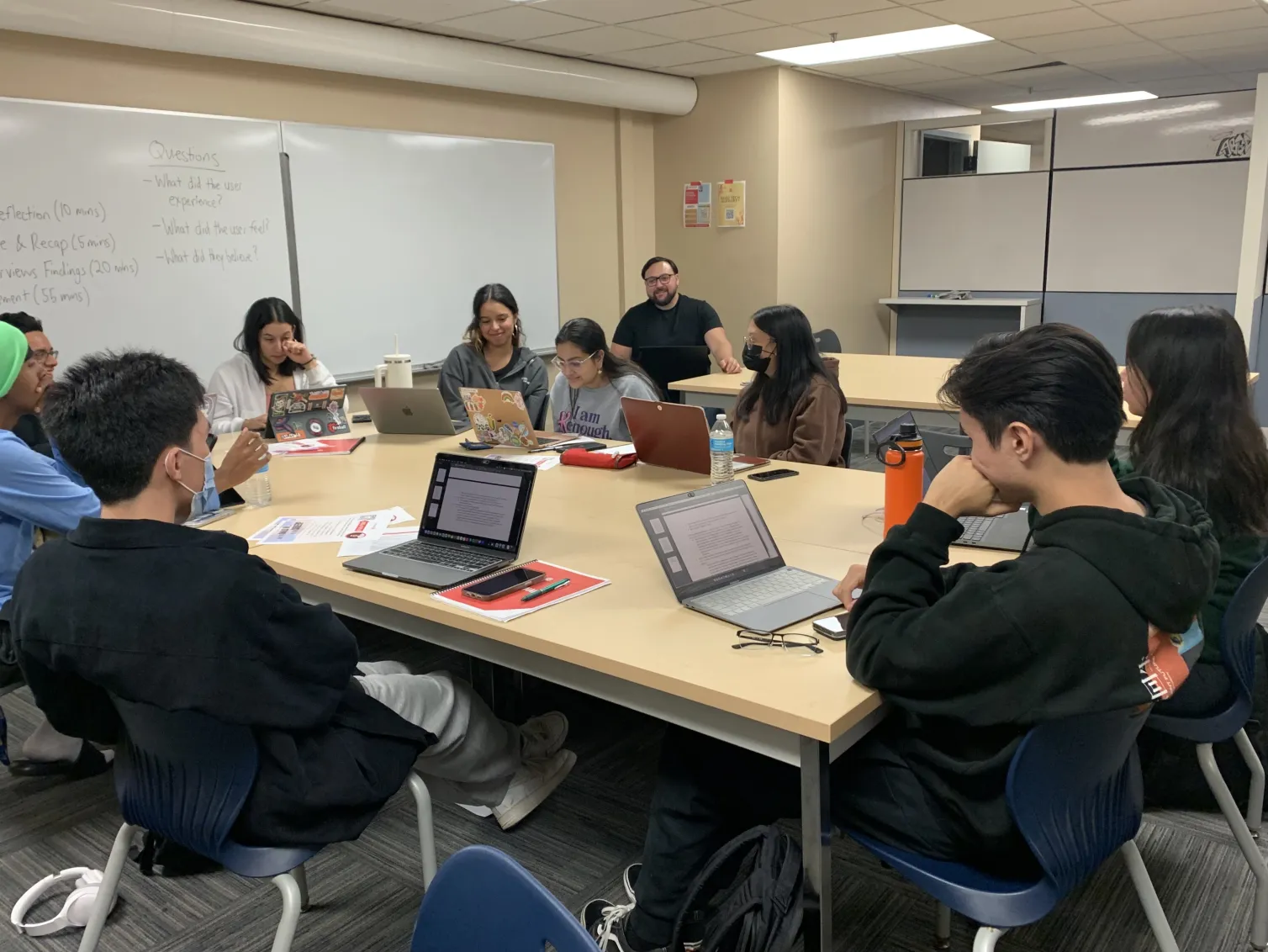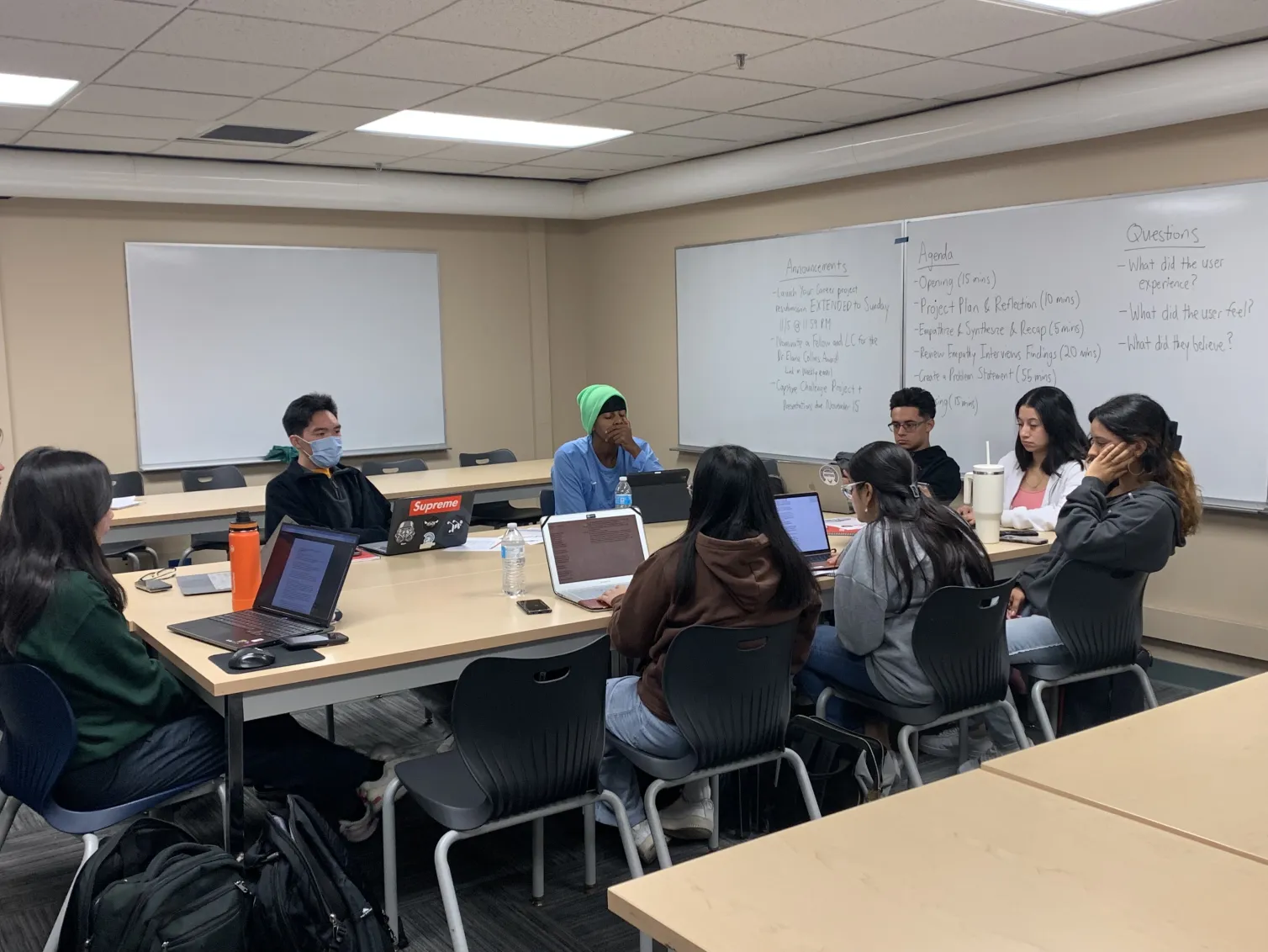Introduction:
Highlights:
During my time at Braven, I had the opportunity to collaborate with a team and participated in a competitive design competition where we got to work for YCD. Youth Community Developers is a program based in San Francisco that helps individuals attain sustainable and generational economic mobilities. During this competition, my team had to go against 8 other teams where we had to solve a problem for YCD.
What strategies can we implement to engage YCD program alumni participation?
During the month working with YCD, I have achieved many milestones, such as:
Co-leading the user research by creating and conducting questions for the user interviews. This helped my team identify the user’s pain points
Collaborating with eight different designers. As a team, we were able to effectively communicate, brainstorm and problem-solve.
Provide support to the prototyping team to create an impactful mobile application.
My Role:
Lead 1 Researcher
Lead Prototyper
Collaborators:
Dustin - Project Manager
Caleb - Lead 2 Researcher
Mithi, Charlene, Phu - Lead Prototypers
Jasmine, Z, Peter - Lead Deck Designers
Duration:
Oct 10, 2023 - Nov 14, 2023
Figma
Google docs
Google Drive
Tools:
Problem Statement:
Because YCD alumni do not have an engaging platform to utilize, they are not notified of current YCD events and opportunities.
OUR DESIGN PROCESS:
01 Empathize
User Interviews
Identify the Problem
02 Ideate
Brainstorming
Possible solutions
03 Design
Low - Fidelity
04 Test
User Testing
High Fidelity
Link
05 Prototype
01 Empathize:
User Interviews
With YCD's question in mind, our team initiated the emphasize stage by tasking the lead researchers with crafting and conducting user interviews with YCD alumni. These interviews aimed to uncover the motivations of alumni and explore their experiences with YCD, encompassing both positive and negative aspects. One key lesson learned from this process was the importance of adaptability. While identifying potential interviewees was straightforward, scheduling and motivating them within tight timelines posed challenges. However, through collaborative effort, we devised strategies such as offering incentives and diversifying our interview pool across different YCD programs. Interviewing alumni from other institutions provided valuable insights into how alternative programs engage and retain alumni. Ultimately, we successfully interviewed a total of 10 participants, using their input to craft a concise problem statement that guided subsequent phases of our project.
Interview Discovery:
Problem Statement:
No involvement due to lack of awareness and marketing
Many alumni weren’t aware of upcoming events, volunteering opportunities, or additional programs to be a part of.
Little-to-no connection with alumni because lack of communication and methods to get notified about present ventures.
Many would rely on word of mouth, but if they have no one to contact, alumni wouldn’t know anything about YCD.
Not connected to the current members of the organization anymore.
After the program alumni lose contact with their peers and mentors. This is due to having a busy life or not having access to contacting them.
Because YCD alumni do not have an engaging platform to utilize, they are not notified of current YCD events and opportunities.
02 Ideate:
brainstorm and possible solutions
During the Ideate stage, our team convened for a brainstorming session, which turned out to be a standout experience due to the diverse array of ideas generated collectively. This process taught me the value of embracing diverse perspectives, as everyone brought unique ideas to the table. Instead of dismissing ideas, we amalgamated them to form comprehensive concepts. One challenge we encountered—and a valuable lesson learned—was the importance of maintaining alignment with our problem statement. There were instances where team members allowed their ideas to alter the problem statement, which led to confusion. Ultimately, we realized that the problem statement should guide our ideation, not the other way around. We reverted to our original problem statement and generated multiple ideas, including organizing reunion events and developing mobile apps. This approach ensured that our solutions directly addressed the identified problem and remained focused on our project objectives.
Brainstorm:
As a group, we came up with the development of the YCD App
Every YCD alumni and current fellows will have their own personal profile that highlights their role
It will implement engagement to YCD alumni participation
Resolving the problem:
Low Fidelity:
03 Design
Low- Fidelity and Mid-Fidelity
With the ideas created as a team and with the help of the lead designers we decided to create a mobile application. This mobile app is to motivate alumni’s to be part of YCD once again. Incentives such as mentorship opportunities, job boards, additional resources, chats, and community rewards.
Mid Fidelity:
Community Rewards
Homepage
Notification
04 Test:
User Feedback
With the mid-fidelity wireframes completed, our team was eager to gather feedback through testing. We reached out to our user interviewees to provide us with valuable insights to enhance our mobile application. Here are some quotes that resonated with us the most:
“The mentorship section is straightforward, but how are the mentors recommended to me?”
“I don’t think that interviewing tips should be in educational resources as it is not based on education.”
“I love the option to gain points and earn YCD Merch, but the community rewards feature was difficult to find.”
05 Prototype
High - Fidelity, Presentation
With the help of user testing the team was finalized the mobile High- Fidelity wireframes and the prototype was ready to present to YCD representatives.
Mentorship Opportunities:
Allows alumni to become mentor for current fellows
Current fellows can seek out mentors in similar field and interests
Mentors are recommended based on fellows’ interests in profile
Job Board & Listings
Purpose is to allow alumni and current fellows with easy accessibility to job opportunities
Includes open-position opportunities from YCD and other city-wide jobs
Opportunity for referral from YCD members
Resources & Chat
Career development resources
Different chat channels where YCD members can communicate with each other
Community
Through our interviews we discovered that one reason the alumni were not engaging with the YCD Community was due to a feeling that their participation lacked reciprocated benefits.
Participate through the activities
Earn rewards for participation
Continue to give back to the community while earning benefits
Presentation:
What I learned:
I thoroughly enjoyed working on this project, largely because of my fantastic team. Not only did I relish the collaboration, but I also gained valuable skills such as networking, adaptability, flexibility, teamwork, and leadership.
One of the key lessons I learned was how to enhance my brainstorming process. I realized that my ideas sometimes led me to tweak the problem statement, whereas it should ideally be the other way around. To address this, I started focusing on the keywords of the problem statement to ensure that my ideas remained aligned with the project's objectives.
Improving my presentation skills was another highlight of this project for me. I used to get very nervous about presenting, but through consistent practice with my team, I gained confidence. Eventually, I was able to deliver successful presentations not only in front of YCD representatives but also to our competitors, showcasing our work effectively. This experience significantly boosted my ability to communicate ideas and findings with clarity and poise.
Challenges:
One of the major challenges we faced during our project was time constraints. It was particularly difficult to find participants within a week whose schedules aligned with those of busy college students. Fortunately, our project manager stepped in and adjusted our deadlines to ensure we could secure a sufficient number of interviewees. Additionally, we used incentives to attract additional participants, which helped overcome this hurdle.
Another significant challenge we encountered was during our brainstorming sessions. Initially, we struggled to reach consensus as everyone had numerous excellent ideas. However, we overcame this challenge by adopting a collaborative approach. We encouraged everyone to keep an open mind and combined our ideas to create comprehensive solutions that addressed our project objectives effectively. This process enabled us to leverage the diversity of our team's creativity and ultimately find common ground to move forward with our project.

